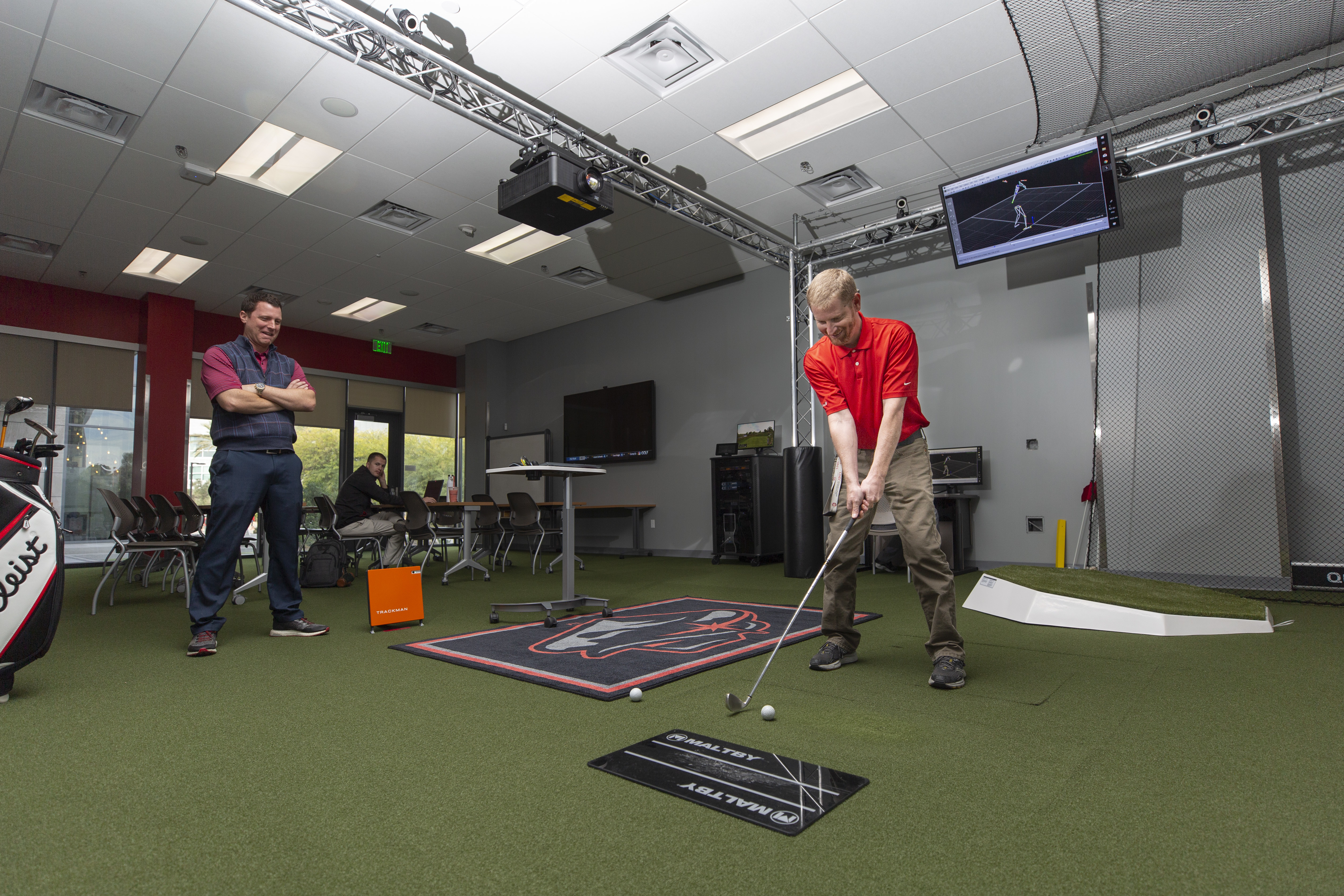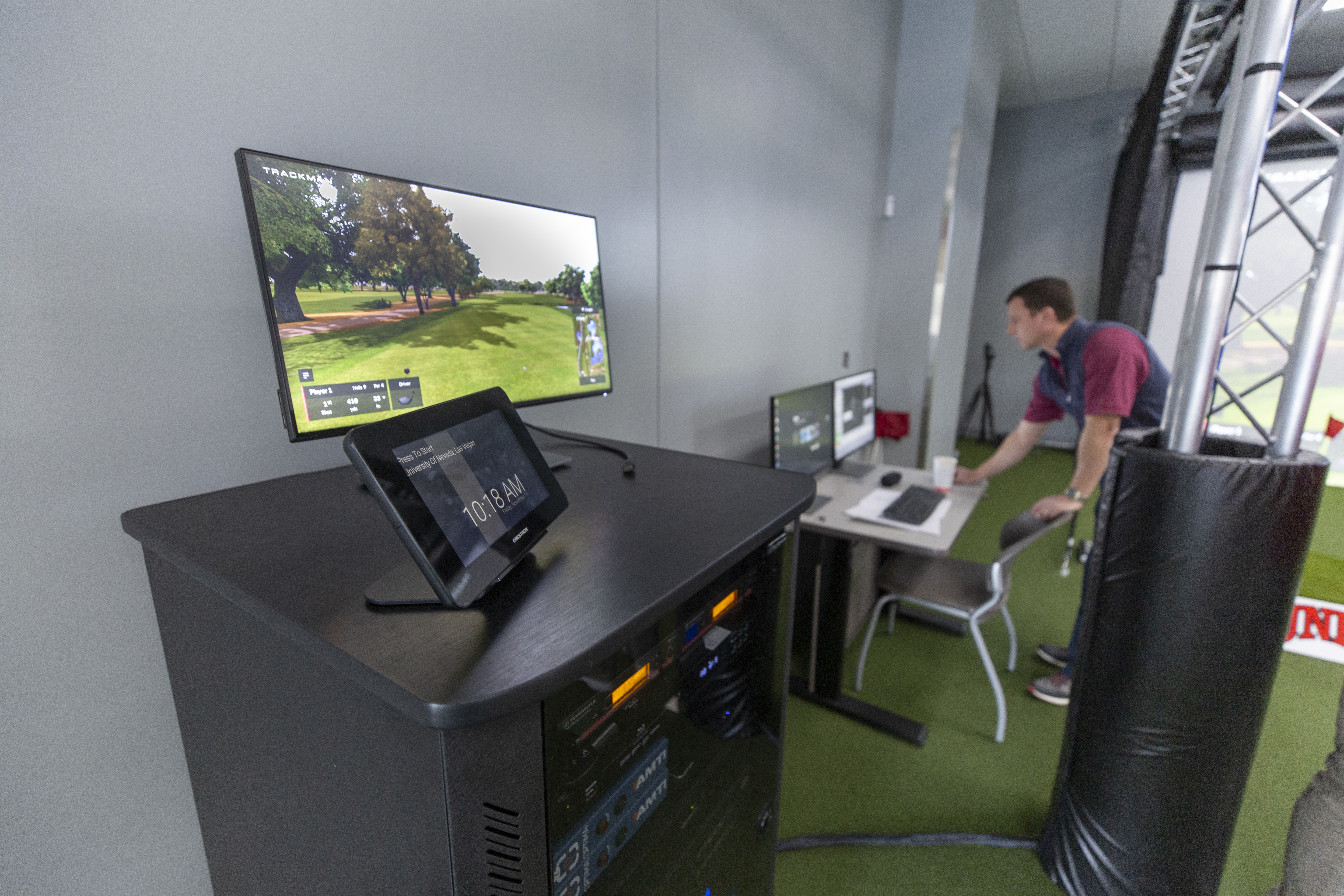Best Shot
The 3D Motion Capture Space at UNLV Is a Hole in One
Hospitality Hall at the University of Nevada, Las Vegas (UNLV) is an impressive addition to the school’s Harrah College of Hospitality. This Silver LEED-certified, 93,500-square-foot space was designed to prepare students for top-tier hospitality professions like those found along the Las Vegas Strip, which is located mere blocks away. Students gain hands-on, real-world experience in several areas within Hospitality Hall; one space that’s gotten a lot of attention from both prospective students and similar programs around the country is the 3D motion capture area for the PGA Golf Management program.
The PGA Golf Management program trains students “to become leaders in the golf industry through classroom instruction, practical internship experience, community service, and other outstanding career development opportunities,” according to the program’s website. To better meet those goals, UNLV decided to add the 3D motion capture space, which is in line with what’s used by facilities that professional golfers visit, as part of the new construction.
“We’re on par with the PGA themselves, with the technology they’re using,” said Frank Alaimo, AV systems specialist, Classroom Technology Services, UNLV. “Students will see these out in the real world.”
[UNLV Dazzles With Sensational Signage]
Alaimo brought in Ford Audio-Video, which was already working ahead of schedule on the installation of Hospitality Hall, to provide integration services for the 3D motion capture space and classroom. The creation of a training area where a golfer’s swing, stance, and more can be measured—all adjacent to a classroom—came with several challenges, not least of which was rigging equipment safely on a truss.
“Safety is our number one priority when rigging equipment, and especially in spaces with people—in this case, students—directly below,” said Randy Robbins. Robbins and Kevin Roberts were the key Ford-AV personnel on this project.
That triangle truss holds quite a bit of equipment, including most of the key components of the 3D motion capture system. The golfer’s image is projected onto the giant, 18-foot screen via a massive 10,000-lumen Hitachi LP-WU9100B DLP laser projector. The golf trainer was initially spec’d with a different projector, but it turned out that when the lights were low enough to not interfere with the projected images, the TrackMan software that’s used for the motion capture wasn’t getting enough light to pick up the sensors.
A daily selection of the top stories for AV integrators, resellers and consultants. Sign up below.
“Compared it to the old one, it was night and day,” said Trevor Brown, assistant director of technology operations at UNLV. “Now we don’t have to mess with the lighting—it can be fully lit, and everything works properly.”

Putting the right projector in place was just one piece of the puzzle. The Qualisys motion capture technology attached to the truss was calibrated to precise specifications by the company, and the cameras have to stay exactly in place to keep the system running as required. To account for potential vibrations, the truss is secured to a concrete slab that is independent from the rest of the concrete of the building, separated by an inch-thick layer of cushioning.
“Even the trusses aren’t attached to the physical structure of the building,” said Alaimo. “The only thing we’ve attached to the building is a power outlet to plug things in. That’s it.”
Two Planar EP5014K 50-inch 4K displays are also attached to the truss, flanking the video projection screen and providing replay of captured swinging motion for left- or right-handed golfers, while six JBL Control 26CT speakers are installed on the ceiling. Directly adjacent and open to the motion capture space is the classroom, which features an 86-inch Planar QE8650-T touchscreen display for analysis review and instruction.
With all that equipment in a space where students are thwacking golf balls, it’s clear that vibrations are just one of the calibration concerns.
“There’s a net above to stop balls from hitting the ceiling or the lights, but the cameras can’t be obstructed by nets, so we’re crossing our fingers that golfers don’t hit a camera,” Alaimo said. “The net is more for people who are walking to that back office, so a ball doesn’t take them out, or so we don’t smash lights or hit the sprinkler heads—as much safety as we can do.”
The system is controlled via a Crestron 3-Series DigitalMedia Presentation System 300 using Crestron touchpanels, which UNLV’s programmer laid out to suit the needs of the room’s users. Content displayed in the classroom can be separate from that shown in the motion capture area, and content from the room can also be distributed to the Samsung QM-F Series LED screen in the nearby pro shop, if desired.

“One of the main things they wanted to do was have a presentation on the large screens in the classroom side, but they still wanted to be able to have something different over in the motion capture area,” Alaimo said. “The biggest requirement was the flexibility to put content anywhere they wanted to. Especially sending it to the pro shop area, so if they were to get a professional golfer to come in, and he was working in that facility, someone could send his data to the screen, and we could send that into the pro shop, live.”
Wiring the system to accommodate these needs while managing the vibration concerns that necessitated the specialty flooring was particularly challenging. One spot that stands out for these considerations is the force plate in the center of the motion capture area. When a golfer stands on the force plate to swing, the plate picks up information about the swing and delivers it back to a computer.
“Imagine that concrete floor with conduits that go back and forth,” Alaimo said. “The trickiest part of this whole thing was getting that big, fat cable through the conduit to where it needed to go. Configuring the whole AV system was a lot easier to do than pulling that cable through the darn floor.”
Another unforeseen complication is one they’re still trying to negotiate. The indoor/outdoor turf in the room combines with the dry Las Vegas weather to create the perfect environment for a buildup of static charge.
“When you touch a touchpanel or any of the equipment, as much as we grounded it, we still find issues,” Alaimo said. “We have people touch something metal before they touch something AV so they don’t restart the system or anything. We might have to put a static mat down in that area. We create a lot of static.”
